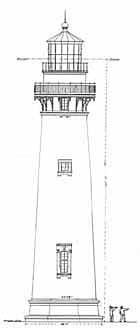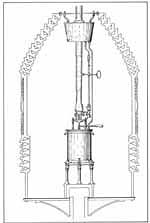Pigeon Point History
How did the Lighthouse get its Name?

The Carrier Pigeon was a state-of-the art, 19th Century clipper ship. She was 175 feet long with a narrow, 34 foot beam and rated at about 845 tons burden. Launched in the fall of 1852 from Bath, Maine, the Carrier Pigeon was valued at $54,000 and started out on her maiden voyage on January 28, 1853. Out of Boston and bound for San Francisco, the Carrier Pigeon was under the command of Captain Azariah Doane. The ship and her cargo were insured for about $195,000.
The Carrier Pigeon made good time around Cape Horn and was enjoying a good passage when she was sighted off Santa Cruz the morning of June 6, 1853. As she continued northward, the Carrier Pigeon ran into heavy fog. By nightfall Captain Doane, believing he had veered far enough from shore, turned the ship eastward, back towards shore in the hope of catching sight of land. Without any warning, there was the sudden sound of splintering timbers! The Carrier Pigeon had ran aground just 500 feet off shore. The waves rocked the ship against the rocks, opening her hull wider and wider to the sea. Captain and crew were able to make it to shore safely. The following morning word of the disaster was sent to San Francisco and requests made for salvage ships to help rescue as much of the cargo as possible.
The U.S. Coast Survey steamer Active was sent to offer assistance and she was soon joined by the sidewheel steamer Sea Bird. The Sea Bird soon ran into its own problems and was beached near Point Año Nuevo to save her from sinking. Although another ship was sent to continue salvage operations, little of the Carrier Pigeon's cargo was saved. Eventually, the Carrier Pigeon which had been valued at $54,000 was sold, where she lay, for only $1,500!
When was Pigeon Point Lighthouse First Lit?
In November of 1872, district lighthouse inspector, Captain Charles J. McDougal, formally examined the Pigeon Point Light Station. At that time Captain McDougal determined the station was ready to begin operations. The district lampist, Thomas J. Winship, made ready the eight-foot tall oil lamp used in the lens and instructed the keepers on its use. On Friday November 15, 1872, at sunset, the lamp was lit, the clockwork placed into action, and Pigeon Point Light Station started operations as an aid to navigation on the central California coast.
Click here to find out more: When Was the Land Purchased for the Lighthouse?
How Tall is the Lighthouse?

100' above ground to the focal plane of the lens.
115' above ground to the top of the tower.
150' (about) above sea level to the focal plane of the lens.
Who Invented the Lens used at Pigeon Point Light Station?
Augustin Fresnel (pronounced fray-nell)
Fresnel (born May 10, 1788, died July 14, 1827), a French physicist, was commissioned by France in 1822 to develop a better lighting system for the French lighthouses. Rather than try to develop a brighter light source, Fresnel set about designing a better, more efficient method of using the light which 1820's technology could produce.
19th Century lighthouses used silvered-metal parabolic reflectors, placed behind a lamp, to direct the light seaward. This system was not very efficient, and worked poorly as an aid to navigation. Remember that light produced by a lamp, or any source, radiates out in all directions. Fresnel's task was to find the most efficient method to direct all, or nearly all, of the lamp's light rays out to sea.
To improve upon the parabolic reflector, Fresnel looked to glass lenses for a method of directing more of the light from a lamp seaward. Molding a single lens to do the job was impractical. A lens suitable for a lighthouse would be far too large to be cast as a single lens. Instead Fresnel designed a system of smaller lens and prisms, arranged in a stair-step configuration. He used this system to bend, fold, and focus the light out to sea. The result was a lens that was able to use about 80 percent of the light available from the lamp! In the case of the lens used at Pigeon Point, about 70,000 candlepower was produced by the original lamp.
This type of lens, called a Fresnel lens, was a technological breakthrough! The new lens was far more efficient in its use of the small amount of light produced by a lard oil lamp. In addition, a Fresnel lens could be disassembled and shipped in sections and configured into virtually limitless numbers of light characteristics, that is, patterns of flashes of light divided by periods of darkness.
When was Lard Oil Introduced as a Fuel in California Lighthouses?
 Although some of California's earlier lighthouses had used the oil from Sperm whales ("sperm oil"), by the late 1860s the California lighthouses, as well as others in the United States, were converted to lard oil. Why the change, you ask? A simple, "bottom line" decision by the Lighthouse Service.
Although some of California's earlier lighthouses had used the oil from Sperm whales ("sperm oil"), by the late 1860s the California lighthouses, as well as others in the United States, were converted to lard oil. Why the change, you ask? A simple, "bottom line" decision by the Lighthouse Service.
During the mid-1800s the population of sperm whales had declined and the industrial demand for the oil had increased. As a result, the price of sperm oil was steadly increasing. Professor Joseph Henry, Lighthouse Board member and secretary of the Smithsonian Institution, had conducted experiments showing lard oil worked as well as sperm oil, and at about half the price!
Why Does a Lighthouse Light Flash?
For a lighthouse to be effective as an aid to navigation, it not only had to be seen, it also had to be identified as a unique location. This was necessary if ships were to use it to determine their own location and avoid hazards. For example, let's say you are the Captain of a ship in 1868, bound for San Francisco out of Australia. For the last four days and nights you have been in heavy fog and unable to take any sightings to confirm your location. Suddenly, out of the fog you see a light! "Great," you think to yourself, "the California coast at last!" But, exactly which part of the coast is it? Is this the lighthouse at Point Bonita, or Point Reyes, or Santa Cruz, or... For a lighthouse, just being seen wasn't enough.
The need to clearly identify each lighthouse was often solved by a specific pattern of flashes per minute. Although sometimes lighthouses identified themselves by using colored light, most made use of a flash of light, followed by a period of darkness. This pattern was called the lighthouse's "characteristic."
Pigeon Point's flash pattern was one flash every ten seconds. Today, Pigeon Point is unusual because it still produces a flash every ten seconds, the same pattern it started with, more than 125 years ago. Now, instead of a lard oil burner, an automated beacon is used. In the late 1880s, seventeen different characteristics were used by lighthouses for identification.
Some of the other lighthouse characteristics used in the 19th Century on the California coast:
Point Bonita--Fixed white light
Point Reyes--White flash once every five seconds
Pigeon Point's Audible Fog Signal
When Did the Fog Signal First go into Operation?
September 10, 1871
Through out Pigeon Point Light Station's years of service there have been four different audible fog signals, each with their own technical requirements for operation.
|
System Type |
Sound |
Characteristic |
Years of Service |
Operated By |
|
Steam Whistle |
Locomotive or |
4 second blast separated |
1871 to 1911 |
Steam pressure produced |
|
Fog Siren |
Air forced through |
2 second blast alternately |
1911 to 1935 |
Compressed-air produced |
|
Two-tone Diaphone |
"Bee-Ohh" |
Same as Fog Siren |
1935 to |
40 PSI Compressed-air |
|
Diaphram |
Single-note |
Same as Fog Siren |
Mid-1960's |
Compressed-air |
Fresnel Lens Sizes
Chart of Fresnel Lenses*
Order by Size
| Order | Height | Inside Diameter |
|---|---|---|
| First | 7' 10" | 6' 1" |
| Second | 6' 1" | 4' 7" |
| Third | 4' 8" | 3' 3" |
| Third and 1/2 | 3' 0" | 2' 5 1/2" |
| Fourth | 2' 4" | 1' 8" |
| Fifth | 1' 8" | 1' 3" |
| Sixth | 1' 5" | 1' 0" |
*Source: Guardians of the Golden Gate: Lighthouses and Lifeboat Stations of San Francisco Bay Ralph Shanks and Lisa Woo Shanks, editor. 1995, Costano Books, ISBN: 0-930268-08-3.
